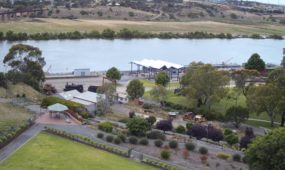Cultivating a garden of the living dead
Tourism
FLOWERING success and advanced propagation techniques are helping an Australian botanic garden amass a leading collection of one of the world’s most mysterious, spectacular and stinky plants.

Sign up to receive notifications about new stories in this category.
Thank you for subscribing to story notifications.
The Botanic Gardens of South Australia has built its collection of Amorphophallus titanum or Titan Arums from three seeds in 2006 to more than 100 plants, making it one of the world’s largest.
Also known as the Corpse Flower because of the rotting-flesh stench produced by the giant flowers, the plants have produced three flowers in the past 13 months, attracting thousands of visitors to see and smell the blooms.
The latest flowering this week has been even more spectacular as it involved a specimen that previously bloomed last February and produced a flower and a leaf simultaneously, both of which botanists say is “unheard of”.
Corpse Flowers typically take about a decade to flower and only flower for 48 hours. They then do not usually flower again for another three to five years.
As a solitary plant in the wild, the Titan Arum relies on its foul smell to attract insects, which carry pollen and cross-fertilise the plant.
Native only to the Indonesian island of Sumatra, the species is threatened by deforestation to make way for palm oil plantations and is extremely difficult to cultivate.
Botanic Gardens of South Australia Horticulture Curator for Plant Propagation Matt Coulter has worked with the plants since the South Australian Botanic Gardens received three Titan Arum seeds in 2006.
“There are so many fascinating aspects to it: how fast it grows when it becomes active – it can grow a metre in a week – the size of the corm can grow to more than 100kg and also the smell of the plant and the way the plant creates its own heat to push the smell out,” he said.
“This particular plant flowered on the first of February last year so to have it flower again in 11 months is unheard of.
“What else is unheard of is the fact the plant has produced a flower and a leaf together – they usually produce them separately – and we think that’s the first time in the world that’s happened.”
The plant (pictured right) has been dubbed “Ganteng” by garden staff, which is the Indonesian word for handsome.
Discovered by botanists in the wild in the 1880s, Amorphophallus titanium enjoyed a surge in popularity in the early 1900s before tapering off. It became popular again in the 1990s when the David Attenborough documentary The Private Life of Plants filmed a Corpse Flower in the wild, leading to renewed interest from botanic gardens around the world and the introduction of the common name Titan Arum.
Horticulturalists at South Australian Botanic Gardens have pioneered leaf-cutting techniques to amass more than 100 young Titan Arum plants.
“We’ve got seven large ones of the flowering size from the three original seeds and three years ago we ran a research program to work out whether we could propagate it through leaf cuttings and that was really successful for us,” Coulter said.
“From that propagation trial we’ve got in excess of 100 plants now. We got a strike rate in the 80 – 90 per cent range, which is really quite phenomenal.
“It’s definitely by far the biggest collection in Australia and if it’s not the biggest in the world it’s one of the largest.”
The remaining five mature plants are expected to flower in the next few years while the 100 cuttings are about five to eight years away.
The plants are grown in a heated glasshouse at the Mount Lofty Botanic Garden in the Adelaide Hills and then transported to the Adelaide Botanic Garden’s Bicentennial Conservatory (pictured below) when they are about to flower.
“This plant is one of the most important plants that botanic gardens’ want to have in their collection because it really brings people in, it’s a really fascinating plant the way it grows and it’s threatened in the wild so running a conservation program is really important for us as well,” Coulter said.
“Because they’ve been grown from cuttings they could come into flower earlier but even if they flower at the traditional 10-year mark, in six or seven years time we should have multiple flowers,” Coulter said.
“We probably view it as the most important plant in our collection so we spend a lot of time working out how to grow it.”
Coulter has visited famous Corpse Flowers around the world including Kew Gardens in London and the University of Bonn in Germany – the world leaders in cultivating this plant – to speak with staff about the plants, which can produce flowers up to 3m tall.
The Botanic Gardens of South Australia plans to eventually have multiple Titan Arum plants flowering simultaneously to boost the profile of its gardens and increase visitor numbers, which currently sit at about 1.9 million a year.
“It’s one of the main plants that really brings people in our aim is to have at least a flower a year or have multiple flowers at the same time, which has probably never happened anywhere before,” Coulter said.
“Quite often you’ll see one flowering in a botanic garden but say in five or six years time when they all become of age for flowering if we could have three or four flowers at the same time it would be really unique and something we are really aiming for.”
It is not the first time Adelaide has focused on Sumatran natives. The neighbouring Adelaide Zoo completed its South East Asia exhibit in 2006, featuring Sumatran Orangutans, Siamangs and Sumatran Tigers.
The garden is fundraising to heat more glasshouses to accommodate the cuttings as they grow but is not planning to grow its Corpse Flower collection further.
“If we start doing more we will run out of space very quickly,” Coulter said.
“At the moment we just want to get the ones we’ve got to come into flower because not many people in the world have ever grown a Corpse Flower from a plant produced from a cutting.
“If we do end up with quite a large mature collection, we might look at doing an exchange with other botanic gardens around the world.”
Jump to next article



